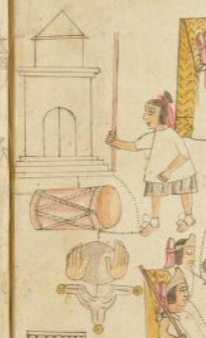tambor (Azca31)
We have given the label tambor (a loanword from Spanish found in Nahuatl) to this unglossed painting of a European drum, which also shows two hands hitting the top of a drum. The cordage tied to the drum has a distinctive European flavor.
Stephanie Wood
The use of the hands to play this drum is interesting, because some European drums were struck with sticks. Most drums in this digital collection are Indigenous, featuring the teponaztli (struck with drumsticks) and the huehuetl (struck with the hands). The Huehuetzilin (MH163r), below, is one example of a drum that might be imported from Europe, and what may be a drumstick resting on top. The round feet of the Huehuetzilin example suggests it is not a huehuetl, which usually has triangular cutouts for legs. The name Huehuetzilin doubles as a personal name. Perhaps the person with this name played a drum. In the contextualizing image for this iconographic example, a man stands nearby, connected to the drum with dots. Also connected is a church, and a glyph for water. Perhaps the drum was featured in a performance at the church that coincided with a baptism?
Stephanie Wood
post-1550, possibly from the early seventeenth century.
Jeff Haskett-Wood
tambores, manos, baquetas, varitas, música, percusión, ritmo
tambor, drum (a loanword from Spanish), https://nahuatl.wired-humanities.org/content/tambor
el tambor europeo
Stephanie Wood
The Codex Azcatitlan is also known as the Histoire mexicaine, [Manuscrit] Mexicain 59–64. It is housed in the Bibliothèque Nationale de France, and hosted on line by the World Digital Library and the Library of Congress, which is “unaware of any copyright or other restrictions in the World Digital Library Collection.”
https://www.loc.gov/resource/gdcwdl.wdl_15280/?sp=31&st=image
The Library of Congress is “unaware of any copyright or other restrictions in the World Digital Library Collection.” But please cite Bibliothèque Nationale de France and this Visual Lexicon of Aztec Hieroglyphs.


